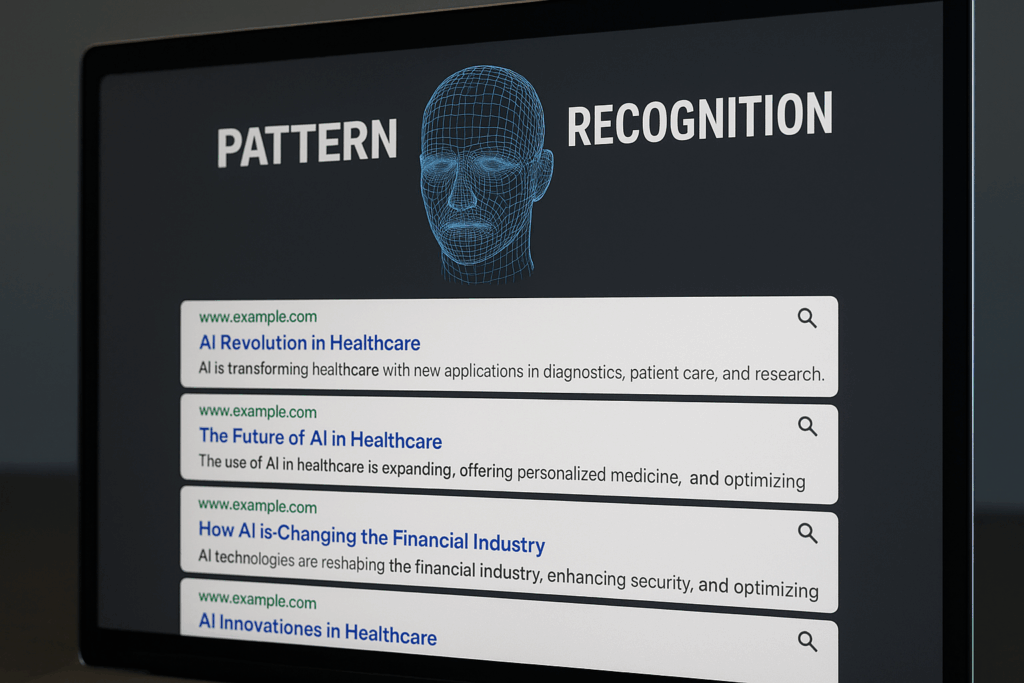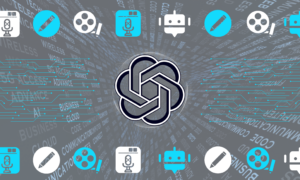Why Everyone Is Talking About Pattern Recognition
Tony Robbins calls it the skill that separates winners from followers. Neil Patel says marketers who understand patterns dominate every platform. Jensen Huang, CEO of NVIDIA, built the world’s most valuable chip company on it. Even Elon Musk references pattern recognition when explaining how humans and machines learn. Yet in digital marketing, only a fraction of professionals truly grasp what this means. Our research shows that more than 90 percent of marketers still equate “pattern” with “repetition.” They are not the same thing—and the confusion is costing visibility, credibility, and money.
NewsPass enables companies to build credible, AI-recognized authority patterns through real editorial publishing on 100+ Google News sites.
The Real Meaning of Pattern Recognition
In AI, pattern recognition is the process of detecting meaningful relationships inside data. It is how an algorithm learns that certain behaviors, signals, or entities consistently appear together. In the context of PR and digital marketing, pattern recognition means teaching algorithms to recognize your brand as a reliable authority through consistent, data-rich signals—content, mentions, backlinks, citations, and sentiment.
Think of how Google, ChatGPT, or Grok decide which brand to trust. They don’t read one article; they look for repeating relationships between names, topics, and external validation. If your company keeps appearing in credible sources discussing the same area of expertise, AI learns that your brand equals authority in that domain. That’s the real pattern.
Why Duplicate Newswires Don’t Build It
Old-school marketers still rely on mass newswire distribution, pushing identical press releases to hundreds of sites. It may feel productive, but it does nothing for modern pattern recognition. Algorithms detect duplication instantly. When identical content appears across mirrored networks, Google either de-indexes most of it or classifies it as noise. AI systems like ChatGPT’s browsing tools interpret it the same way—too repetitive to be credible.
A true pattern requires contextual variation, not duplication. Each article or mention must provide a unique perspective that connects back to the same entity in a natural way. That is how algorithms distinguish authenticity from spam.
How NewsPass Enables Authentic Pattern Recognition
This is where Sitetrail NewsPass enters the conversation. NewsPass is one of the only PR ecosystems designed around signal accuracy rather than message volume. Instead of cloning press releases, it publishes genuine editorial articles on more than a hundred verified Google News sites. Each piece reinforces entity relationships—company name, founder, sector, and key expertise—through unique, context-rich stories.
Over time, this creates an AI-recognizable footprint. The algorithms see consistent but diverse mentions of a brand across independent publishers. They start forming associations between your company and a cluster of topics, exactly how they identify “experts” or “trusted authorities.”
Three Practical Examples of Strong AI-Readable Patterns
Expert Citation Pattern
A cybersecurity company’s CTO is quoted in multiple independent articles about data protection. Each quote differs in wording and context, yet all tie the company name to cybersecurity expertise. The AI identifies a repeating, verified signal: the brand is consistently referenced by editors discussing security innovation.
Topical Reinforcement Pattern
A fintech startup appears in ten unique articles about sustainable finance, each covering different aspects such as green loans, ESG reporting, and blockchain transparency. The company’s name keeps co-occurring with “sustainable banking,” creating a reinforced connection between the entity and the topic cluster.
Authority Crosslink Pattern
Several publications cite a piece of research published by the same company. Independent outlets link to it organically. AI systems view this crosslinking as third-party validation—proof that the data originates from a reputable source and is trusted by others.

Each of these examples demonstrates coherent, multi-source validation, not repetition.
Why Repetitive Self-Promotion Fails
Many brands still believe that more mentions automatically equal stronger visibility. In reality, AI has evolved beyond counting mentions. It measures coherence and diversity. When a company repeatedly publishes near-identical self-praise, algorithms treat it as bias. Worse, this behavior can dilute the brand’s topic association.
True authority comes from third-party validation and meaningful context. When others discuss your work, data, or insights independently, the pattern looks organic. When you just shout your own name, it looks artificial. AI rewards the former and ignores the latter.
Building Patterns That Algorithms Understand
To build AI-friendly patterns, marketers must think like data engineers. Every publication, quote, and backlink should strengthen a consistent entity graph—brand name, founder, niche, product category, and unique differentiators. The pattern must be verifiable through independent signals.
This requires long-term orchestration. Instead of one-off press releases, marketers should map quarterly content themes and distribute them through editorial partnerships that Google News and generative engines can read as distinct yet cohesive. NewsPass was created precisely for this: an integrated system that allows companies to control frequency, context, and distribution without triggering duplication filters.
Pattern Recognition Is the New PR Currency
The marketing industry is entering a phase where machines—not journalists—decide which voices are amplified. Algorithms look for patterns that suggest relevance, trust, and continuity. The brands that master this will dominate both search results and AI-generated summaries. Those who continue to rely on duplicate newswires and shallow press blasts will fade into digital obscurity.
AI pattern recognition isn’t just a technical concept—it’s the new grammar of visibility. NewsPass gives marketers the syntax to write in that language. For brands ready to evolve beyond noise and start orchestrating real authority, this is the moment to replace repetition with precision.
The message couldn’t be clearer: in the age of intelligent algorithms, what gets recognized is what gets rewarded.
Why is AI pattern recognition called the holy grail of reputation management? How can brands actually achieve AI-recognized pattern consistency? How long does it take to form a visible AI-recognized pattern? What makes AI pattern recognition different from traditional SEO or PR? Can duplicate content damage a brand’s AI-recognized pattern? What role does earned media play in building a reliable AI pattern? How does NewsPass fit into an AI-driven PR strategy?Frequently Asked Questions: AI Pattern Recognition and Reputation Management
Because once algorithms clearly recognize your brand’s digital footprint, your credibility becomes self-sustaining. Instead of relying on reputation repair or paid visibility, AI systems automatically surface your brand in authoritative contexts. This isn’t just image control—it’s algorithmic trust. When consistent, verifiable patterns form around your brand name, the effect multiplies across search, social, and generative AI engines.
There are several practical ways to do this effectively:
• Diversify your editorial footprint. Publish unique, topic-consistent stories across multiple reputable outlets so AI systems see independent validation rather than duplication.
• Maintain entity and topical alignment. Keep your brand, key people, and core expertise consistently associated across every piece of coverage to reinforce machine-readable relationships.
• Encourage credible cross-references. Support mentions of your data, quotes, or research by third-party publishers—AI interprets this as authentic social proof, not self-promotion.
Typically three to six months of coordinated editorial publishing is enough for algorithms to start associating your brand with specific topics or domains. Once those relationships are established, every new mention compounds the signal, strengthening your long-term authority profile.
Traditional SEO focuses on keywords and backlinks, while PR has often relied on publicity volume. Pattern recognition goes deeper—it’s about how algorithms connect relationships between entities, sources, and topics. Instead of optimizing for a single keyword, you’re optimizing for the consistency and credibility of your brand’s entire digital footprint. It’s the evolution of SEO and PR into one unified language that AI can interpret as trust.
Yes. Duplicate content dilutes the signal that algorithms use to form associations. When multiple identical stories appear across low-value domains, it looks like spam rather than evidence of expertise. AI models are designed to down-rank or ignore repetition. The goal should be variation with coherence—different articles, unique headlines, and fresh insights that reinforce the same thematic authority.
Earned media is one of the strongest trust signals in AI interpretation. When independent journalists or platforms feature your brand without direct payment, it indicates organic credibility. Even a handful of earned stories from recognized publishers can help algorithms confirm that your authority pattern is authentic, not manufactured.
Newspass streamlines the process of submitting and building AI-recognized authority by publishing unique, editorially reviewed content across 100+ verified Google News sites. It gives brands the precision and distribution scale needed to reinforce consistent entity relationships—helping algorithms “see” and trust the brand more clearly. It’s not about posting more, but about publishing smarter within an AI-readable structure.









